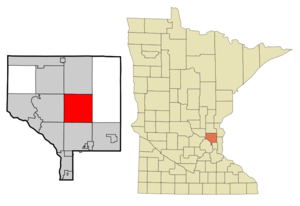- Ham Lake, Minnesota
Infobox Settlement
official_name = Ham Lake, Minnesota
settlement_type =City
nickname =
motto =
imagesize =
image_caption =
image_
imagesize =
image_caption =
image_
mapsize = 250px
map_caption = Location of Ham Lake, Minnesota
mapsize1 =
map_caption1 =subdivision_type = Country
subdivision_name =United States
subdivision_type1 = State
subdivision_name1 =Minnesota
subdivision_type2 = County
subdivision_name2 = Anokagovernment_footnotes =
government_type =
leader_title =
leader_name =
leader_title1 =
leader_name1 =
established_title =
established_date =unit_pref = Imperial
area_footnotes =area_magnitude =
area_total_km2 = 92.5
area_land_km2 = 89.2
area_water_km2 = 3.2
area_total_sq_mi = 35.7
area_land_sq_mi = 34.5
area_water_sq_mi = 1.3population_as_of = 2000
population_footnotes =
population_total = 12710
population_density_km2 = 142.4
population_density_sq_mi = 368.9timezone = Central (CST)
utc_offset = -6
timezone_DST = CDT
utc_offset_DST = -5
elevation_footnotes =
elevation_m = 274
elevation_ft = 899
latd = 45 |latm = 15 |lats = 16 |latNS = N
longd = 93 |longm = 12 |longs = 57 |longEW = Wpostal_code_type =
ZIP code
postal_code = 55304
area_code = 763
blank_name = FIPS code
blank_info = 27-26738GR|2
blank1_name = GNIS feature ID
blank1_info = 0659991GR|3
website =
footnotes =Ham Lake is a city in Anoka County,
Minnesota ,United States . The population was 12,710 at the 2000 census.Minnesota State Highway 65 serves as a main arterial route in the city.Geography
According to the
United States Census Bureau , the city has a total area of 35.7square mile s (92.5km² ), of which, 34.5 square miles (89.2 km²) of it is land and 1.2 square miles (3.2 km²) of it (3.50%) is water.Adjacent cities
*East Bethel (north)
*Blaine (south)
*Andover (west)History
The earliest record of settlers in this area goes back to 1855, and in 1856 the group started a town. This was just south and west of a lake shaped like a ham. They platted and sold lots for a town they named, "Glen Carey," a Scottish name meaning "Beautiful Valley." The place was widely advertised as a future city. However, in 1857 all of the houses were destroyed by a prairie fire. Some of the inhabitants barely escaped with their lives saving only a very few household goods. They soon left the area as they had nowhere to live. There was no more settlement until 1866 when a Norwegian man settled in the area. He was soon followed by other Scandinavians. The Scandinavian settlers found it difficult to pronounce the Scottish name of Glen Carey. Since no name had been chosen by the people, the commissioners named it "Ham Lake," after the lake which had acquired that name on account of its shape.
The early settlers found the soil well suited to farming as it wasn't as rocky as they had been accustomed to in Scandinavia. Through the years, dairying became an important industry. The pioneer farmers soon found the soil well suited to growing potatoes and this became an important commodity for both cash sales and trading. From the early 1900's through the 1930's potato farming was at its peak in Ham Lake Township. The only farms remaining today are the sod farms in the southeastern part of the city, where the ground is low and the soil black and heavy making it well suited to this crop.
In 1894 when the population was over 400 people a group of farmers joined together to form a cooperative and built a creamery. Several general stores were built there shortly afterwards. What became the main store in town, Soderquist's, was built on land sold to the Soderquist family by the Olson family, who had extensive landholdings along what would become Highway 65. Like many small American towns, over time all the "old" families became related through marriage. Although many of the establishing families have since moved away from Ham Lake due to increasing property taxes and crowding, these familial connections remain firm and many members of the families are still in close contact.
In 1922 a garage was opened in the northern part of the town.
A Fire Department was established 1969 with Eldon Hentges as the first Fire Chief.Ham Lake officially became a city on Jan. 8, 1974, with Eldon Hentges serving as the first mayor.
Demographics
As of the
census GR|2 of 2000, there were 12,710 people, 4,139 households, and 3,472 families residing in the city. Thepopulation density was 368.9 people per square mile (142.4/km²). There were 4,208 housing units at an average density of 122.1/sq mi (47.2/km²). The racial makeup of the city was 96.70% White, 0.50% African American, 0.39% Native American, 0.76% Asian, 0.04% Pacific Islander, 0.37% from other races, and 1.25% from two or more races. Hispanic or Latino of any race were 1.14% of the population.There were 4,139 households out of which 45.9% had children under the age of 18 living with them, 74.0% were married couples living together, 6.0% had a female householder with no husband present, and 16.1% were non-families. 11.4% of all households were made up of individuals and 2.5% had someone living alone who was 65 years of age or older. The average household size was 3.07 and the average family size was 3.33.
In the city the population was spread out with 31.0% under the age of 18, 7.5% from 18 to 24, 33.8% from 25 to 44, 23.4% from 45 to 64, and 4.2% who were 65 years of age or older. The median age was 34 years. For every 100 females there were 109.3 males. For every 100 females age 18 and over, there were 106.2 males.
The median income for a household in the city was $67,750, and the median income for a family was $71,905. Males had a median income of $44,462 versus $31,239 for females. The
per capita income for the city was $24,329. About 1.2% of families and 2.1% of the population were below thepoverty line , including 1.3% of those under age 18 and 3.0% of those age 65 or over.References
Wikimedia Foundation. 2010.


